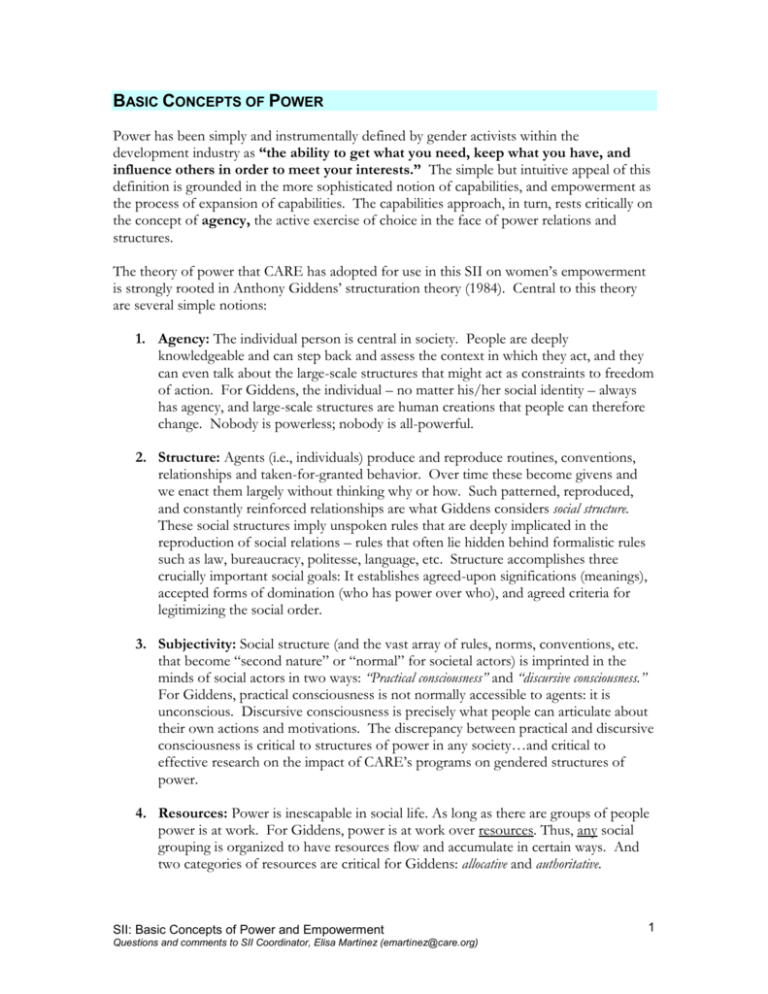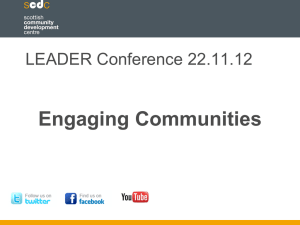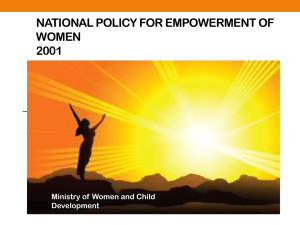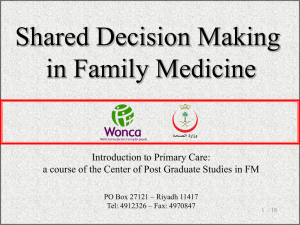
BASIC CONCEPTS OF POWER
Power has been simply and instrumentally defined by gender activists within the
development industry as “the ability to get what you need, keep what you have, and
influence others in order to meet your interests.” The simple but intuitive appeal of this
definition is grounded in the more sophisticated notion of capabilities, and empowerment as
the process of expansion of capabilities. The capabilities approach, in turn, rests critically on
the concept of agency, the active exercise of choice in the face of power relations and
structures.
The theory of power that CARE has adopted for use in this SII on women’s empowerment
is strongly rooted in Anthony Giddens’ structuration theory (1984). Central to this theory
are several simple notions:
1. Agency: The individual person is central in society. People are deeply
knowledgeable and can step back and assess the context in which they act, and they
can even talk about the large-scale structures that might act as constraints to freedom
of action. For Giddens, the individual – no matter his/her social identity – always
has agency, and large-scale structures are human creations that people can therefore
change. Nobody is powerless; nobody is all-powerful.
2. Structure: Agents (i.e., individuals) produce and reproduce routines, conventions,
relationships and taken-for-granted behavior. Over time these become givens and
we enact them largely without thinking why or how. Such patterned, reproduced,
and constantly reinforced relationships are what Giddens considers social structure.
These social structures imply unspoken rules that are deeply implicated in the
reproduction of social relations – rules that often lie hidden behind formalistic rules
such as law, bureaucracy, politesse, language, etc. Structure accomplishes three
crucially important social goals: It establishes agreed-upon significations (meanings),
accepted forms of domination (who has power over who), and agreed criteria for
legitimizing the social order.
3. Subjectivity: Social structure (and the vast array of rules, norms, conventions, etc.
that become “second nature” or “normal” for societal actors) is imprinted in the
minds of social actors in two ways: “Practical consciousness” and “discursive consciousness.”
For Giddens, practical consciousness is not normally accessible to agents: it is
unconscious. Discursive consciousness is precisely what people can articulate about
their own actions and motivations. The discrepancy between practical and discursive
consciousness is critical to structures of power in any society…and critical to
effective research on the impact of CARE’s programs on gendered structures of
power.
4. Resources: Power is inescapable in social life. As long as there are groups of people
power is at work. For Giddens, power is at work over resources. Thus, any social
grouping is organized to have resources flow and accumulate in certain ways. And
two categories of resources are critical for Giddens: allocative and authoritative.
SII: Basic Concepts of Power and Empowerment
Questions and comments to SII Coordinator, Elisa Martínez (emartinez@care.org)
1
Allocative resources are those capabilities that command control over objects, goods, or
material life. Authoritative resources refer to control over people.
Power, it follows, can have many forms – economic, political, social, cultural, and symbolic –
and actors rarely dominate them all. No actor is powerless: everyone, for example, has the
ability to reflect on relationships between structure and agency, to learn, and to take
individual or organize collective action.
Another consequence of Giddens’ thinking is that power is not necessarily a zero-sum game:
just because one social actor has power does not mean that others do not, nor does the
accumulation or loss of power by a social actor automatically mean that some other social
actor gained or lost the same amount. And finally, “power” itself is a socially constructed
category, one that does not necessarily have the same social signification in, say, Harlem,
New York, as it does in Kandahar, Afghanistan.
Finally, Giddens’ theory of structuration directs us to the different “modes” in which power
operates and shows that power is simultaneously present and acting in a number of
dimensions.
Personal: Power within, Power To: An individual’s ability to know, pursue, and, in
some cases, achieve their interests. Based on self-images, other-images, skills, resources,
and motivations.
Interpersonal: An individual’s ability to influence other agents and structures around
her/him, in order to achieve their interests – can be cooperative (power with) or
controlling (power over). This latter takes important implications when applied to the
structural domain, in visible, hidden, and invisible forms:
Visible: Derives from the formal/public forms, rules, and processes governing the
interpersonal processes (i.e., membership in collectives, electoral laws, budgets).
Hidden: Determines which agents/agendas become part of the interpersonal
process – and the ability to control (often behind the scenes) the settings in which
agents interact.
Invisible: Define, through processes of acculturation, the very field of the
“possible,” the “reasonable” or the “logical.” Examples include kinship in some
societies, capitalism, religion, science, and education. This kind of power comprises
and maintains the macro political economy and serves to define the “possible field of
action of others.”
For an individual woman, the experience of power and powerlessness will be different based
on race, class, or age, and may even be contradictory in different realms of her life. For
example, a woman politician who appears confident in public may accept a subordinate role
in her family; she may even survive abuse in her private relationships while keeping up with
the demands and image of her public duties. Throughout the world, it is common for a
SII: Basic Concepts of Power and Empowerment
Questions and comments to SII Coordinator, Elisa Martínez (emartinez@care.org)
2
woman to face the same work demands as her male partner, but be primarily or solely
responsible for the maintenance of the home and children.
The challenge of AIDS prevention further illustrates some of the contradictions that occur
with regard to relations of power in the intimate realm. Many seemingly educated,
empowered women and men around the world fail to take measures to protect themselves
against the disease despite the knowledge and resources to do so.
Acknowledging these layers and contradictions can be helpful in understanding the tensions
generated by empowerment for many women. Strategies that focus solely on the public
realm may overlook some critical challenges facing women who are leaders, active citizens,
and public officials when they return to their homes and families. It is from this perspective
that women activists argue that good citizenship for women and for men is not solely about
public behavior.
SII: Basic Concepts of Power and Empowerment
Questions and comments to SII Coordinator, Elisa Martínez (emartinez@care.org)
3
WHAT IS WOMEN’S EMPOWERMENT?
CARE’s treatment of the SII theme of women’s empowerment derives directly from our
understanding of how poor women and men navigate the livelihood choices and
opportunities available to them, our recognition of the dynamic and contested nature of
even the most enduring systems of gender relations, and our growing recognition that
sustainable empowerment for women relies on a combination of changes and interactions
affecting social positions, material conditions, and the broader structural environment.
Empowerment is defined broadly as “the expansion of assets and capabilities of poor
people to participate in, negotiate with, influence, control, and hold accountable the
institutions that affect their lives.”1 Notable in this definition is the recognition of
empowerment as a process of building capability (and not simply the material outcomes visible in
CARE’s impact frameworks to date), and of the importance of structure as represented by the
institutions affecting people’s lives.
This broad conception can be further grounded in a feminist theory as “the expansion in
people’s ability to make strategic life choices in a context where this ability was
previously denied to them.”2 This definition is notable in its focus on choice, which Kabeer
defines as comprising three critical elements: agency (power within/to), operationalized in
reference to resources (power to/over), and made visible in its resulting beneficial/valued
achievements. And finally, agency is exercised, in this conception of empowerment, in
opposition to a prior condition of subordination in important (strategic) arenas of life.
Strategic interests, in gender and development theory, differ from “practical gender needs,”
in that they go beyond the basic functions/capacities which allow people to fulfill the gender
roles assigned to them, and aim to open new gendered spaces of ideology, action and
opportunity. In this sense, empowerment is importantly tied to impact on the structural
underpinnings of women’s subordinate status and well-being.
Other Definitions of Empowerment:
Save the Children defines the end result of empowerment as: “People can make choices and take
actions on their own behalf with self-confidence, from a position of economic, political and social strength.”
The United Nations Development Fund for Women (UNIFEM) includes the following
factors in its definition of women’s empowerment:
Acquiring understanding of gender relations and the ways in which these relations
can be changed
Developing a sense of self-worth, a belief in one’s ability to secure desired changes
and the right to control one’s own life
Gaining the ability to generate choices and exercise bargaining power
Developing the ability to organize and influence the direction of social change to
create a more just social and economic order, nationally and internationally
1
Narayan, Sourcebook on Empowerment. World Bank 2001.
Kabeer, “The Conditions and Consequences of Choice: Reflections on the Measurement of Women’s
Empowerment,” UNRISD Discussion Paper 108, August 1999.
2
SII: Basic Concepts of Power and Empowerment
Questions and comments to SII Coordinator, Elisa Martínez (emartinez@care.org)
4
FRAMEWORK FOR WOMEN’S EMPOWERMENT
One of the key underlying causes of poverty is the construction in different contexts of what
it means to be a man, or a woman. Gender is, in this sense, one manifestation of a general
model of power which holds that individual and group behaviors produce social structures
(ideologies, rules, institutions) which, in turn, reinforce and “normalize” those behaviors to
the point where they are seen as common sense, as the “normal” order of things. Identities,
roles, and relationships are, in this view of things, socially constructed, as are the constraints
and opportunities that certain actors face regarding control of, access to, and use of tangible
and intangible resources.
Gendered forms of power come into play in the social construction of identities, roles,
relationships and distribution of resources, all of which are intimately related to women’s
human rights and the question of poverty. These gendered “rules of the game” are not
always perfectly obvious to women and men who live by them but can be surfaced,
discussed, and challenged through personal and collective consciousness and actions. In this
way, women and men contest the flow of resources, agendas and ideologies.
With this conceptualization of power and social change, empowerment should be conceived
of as both process and outcome3 that comprises three dimensions—agency, structure, and
relationships.
AGENCY: the aspirations, resources, actions and achievements of women themselves;
carrying out their own analyses, making their own decisions, and taking their own actions.
Every person has agency, every person analyses, decides, and acts. Agency is a
continuum, from less to more. Empowerment involves a journey through which poor
women increase their agency.
STRUCTURE: the broader social structures that condition women’s choices and
chances. Routines, patterns of relationships and interaction, and conventions that lead
to taken-for-granted behavior; institutions that establish agreed-upon meanings, accepted
(“normal”) forms of domination (who “naturally” has power over what or whom), and
agreed criteria for legitimizing the social order. Individual agents both produce and are,
in important ways, produced by structure. Structures can be both tangible and
intangible; they are composed of both behavioral patterns that can be observed and
counted but also the ideologies that underpin why some behaviors – or thoughts – are
socially acceptable (acceptable to whom?). Examples include kinship, economic markets,
religion, castes and other forms of social hierarchies, educational systems, political
culture, resource control/ownership dynamics, forms of organization, and many, many
more.
As a process, empowerment is the expansion of women’s individual and collective capacities to access, influence,
and control resources; to confront and challenge gender norms and structures of power; and to negotiate with,
influence, control, and hold accountable the actors and duty bearers that mediate between structural inequities and
women. As an outcome, empowerment results in 1) greater access to, influence over, and control of a) economic, b)
ideological, c) political, d) social, and e) cultural capital, and 2) enhanced ability to understand and analyze the terms
and conditions of gender exclusion and discrimination.
3
SII: Basic Concepts of Power and Empowerment
Questions and comments to SII Coordinator, Elisa Martínez (emartinez@care.org)
5
RELATIONS: the social relationships through which women negotiate their needs
and rights with other social actors, including men. Both agency and structure are
mediated through relationships between and among social actors while, at the same time,
forms and patterns of relationships are deeply influenced – frequently in hidden ways –
by agency and structure. Empowerment, in part, consists in individual women building
relationships, joint efforts, coalitions, and mutual support, in order to claim and expand
agency, alter inequitable structures, and so realize rights and livelihood security.
These three dimensions are intimately related, structuring and influencing one another. The
graphic (below) helps to visualize the way that agency, structure, and relational dynamics
interact to create (or undermine) an empowerment process. In order to be in a position to
have a sustainable impact on women’s empowerment, CARE projects must in some way,
shape, or form, be targeting changes in all three dimensions of women’s empowerment.
Structure
Routines, conventions, relationships
and taken-for-granted behavior
Institutions that establish agreed-upon
significations (meanings), accepted
forms of domination (who has power
over what or whom), and agreed
criteria for legitimizing the social order.
23
SubDimensions
Agency
Relations
Connecting with other social actors,
building relationships, joint efforts,
coalitions, and mutual support, in order
to claim and enact agency, alter
structure, and so realize rights
and livelihood security
Carrying out our own analyses,
making our own decisions, and
taking our own actions.
Empowerment involves poor women
becoming the agents of their own
development.
Causation in this framework model:
1. There is no one, uniform causal pathway. Causation can flow from any of the three dimensions to
another.
2. There is no guarantee that changes in one dimension lead to changes in any of the other two.
3. Processes of empowerment are nonlinear: individual or group empowerment can come and go,
weaken and strengthen, move forward, freeze, or regress.
4. Sustainable changes in empowerment are only possible when changes occur across all
three dimensions.
SII: Basic Concepts of Power and Empowerment
Questions and comments to SII Coordinator, Elisa Martínez (emartinez@care.org)
6
Women’s empowerment differs from culture to culture and context to context. It cannot be
applied uniformly across the developing world. To uncover local women’s own definitions
and indicators of their empowerment, the framework asks researchers to at least consider the
relevance of 23 sub-dimensions of agency, structure, and relations. These subdimensions were selected because they have been shown to be widely relevant to women’s
empowerment across a great many studies and across numerous social, economic, cultural,
historical, and political contexts. In other words, a wide variety of studies have shown an
apparent positive relationship between increases/improvements in the sub-dimensions and
women’s empowerment.
In asking staff to at least consider these sub-dimensions we are not pre-determining local
meanings of women’s empowerment, nor the indicators that are most relevant to decide if
CARE is having an impact or not, but rather trying to inform staff of important results that
already are found in the rather wide literature on women’s empowerment so that we don’t
reinvent the wheel at every site. These 23 sub-dimensions are briefly defined below:
WE Framework Sub-dimensions
1) Self-image; self-esteem (Positive images of self; belief in one’s abilities to influence, act,
decide; feelings of self-efficacy.)
2) Legal / rights awareness (Knowledge of laws around issues of women’s social positions,
status, equality, etc.; knowledge of rights under the law.)
3) Information / skills (Access to information, capacities and skills that a woman deems
helpful or necessary.)
4) Educational attainment (Access to and ability to deploy formal and informal forms of
education, e.g. adult training / learning.
5) Employment / control of labor (Fair and equitable access to employment opportunities;
fair and equitable working conditions; freedom to chose forms of labor.)
6) Mobility in public space (Freedom and safety to circulate in public spaces; Ability to use
transport e.g. bike, bus, taxi.)
7) Decision influence in household finance & child-rearing (Kinds of decisions that women
can make over household resources, processes, people, investments, etc.)
8) Group membership / activism (The degree to which women are free to join groups as a
result of their own wishes to do so.)
9) Material assets owned (The kinds of material assets e.g. land, goods, animals, crops,
money, that women have the power to control.)
SII: Basic Concepts of Power and Empowerment
Questions and comments to SII Coordinator, Elisa Martínez (emartinez@care.org)
7
10) Body health / integrity (Access to core health services of acceptable quality; freedom to
make decisions over what happens to a woman’s own body; a right to bodily well being
and pleasure; exposure to gender-based violence/coercion.)
11) Marriage/Kinship rules & roles (Degree of freedom and control of marital resources;
equitable inheritance, divorce, and family law more generally; control of one’s own body;
cultural, social, and historical norms, conventions, customs in the household, extended
family, clan, and other relevant social groups.)
12) Inclusive & equitable notions of citizenship (Degree of inclusiveness and equity of laws
and practices around what it means to be a citizen; Degree to which women’s human
rights are enshrined in the law of the land and to which such rights are
believed/respected by citizens.)
13) Transparent information & access to services (Degree to which duty bearers ensure that
women have the chance to know what is needed for enjoyment of human rights, how
they can access this, and what to do in the event that they are denied information or
services.)
14) Enforceability of rights, access to justice (Enforceability of human rights claims as well
as specially designed laws and judicial services to promote gender equity; degree to which
customary and formal authorities enforce such rights, and that judiciary authorities
upholds such rights and hold duty bearers accountable)
15) Market accessibility [labor/credits/goods] (Equitable access to employment, credit,
inputs, and products; fair prices; control of capital, etc.)
16) Political representation (Extent of women elected and appointed to public office – in the
formal and informal spheres – and their degree of influence once there; degree to which
women’s rights and women’s issues are visible and influential in the formal, public,
political space.)
17) Share of state budgets (Allocations the state offers for important services, guarantees,
and enforcement mechanisms around issues central to gender equity)
18) Density of civil society representation (The density and quality of civil society
organizations that address gender inequity and social exclusion .)
19) Consciousness of self / others as inter-dependent (Awareness of own power in relation
to others, and reliance of others on self; relational norms/patterns of
exploitation.)consciousness of “subordinate power” in hierarchical relations e.g. with
husband, mother-in-law ability to see leverage and mutual advantage in joint actions both
for self and for others;)
20) Negotiation/ Accommodation habits (Ability and interest in engaging duty bearers, the
powerful, but also other marginalized social actors in dialogue; relational norms/patterns
of conflict and compromise)
SII: Basic Concepts of Power and Empowerment
Questions and comments to SII Coordinator, Elisa Martínez (emartinez@care.org)
8
21) Alliance/Coalition habits (Extent to which women and women’s groups form larger
alliances and coalitions and seek collective gains.)
22) Pursuit / acceptance of accountability (Skills, confidence, and knowledge to hold duty
bearers and the powerful accountable; recognition that human rights also bring forms of
accountability to every individual)
23) New social forms (Social and structural recognition of non-traditional household forms;
generation of new kinds of organizing, new or altered relationships, new kinds of
behaviors.)
To summarize, the 23 sub-dimensions written above may or may not be important in a
particular social context and the concrete indicators that would show improvement along
one of the sub-dimensions may well differ from place to place, era to era in the same place,
or even from group to group of women in the same place and time. Nonetheless, we are
interested in whether and how CARE programs purporting to focus on gender and/or
women’s empowerment are targeting these sub-dimensions as they appear so frequently in
the gender and women’s empowerment literature.
SII: Basic Concepts of Power and Empowerment
Questions and comments to SII Coordinator, Elisa Martínez (emartinez@care.org)
9
REVISITING OUR UNDERSTANDING OF WOMEN’S EMPOWERMENT
From the first phase of our SII research, we had already begun to notice important ways in
which the realities discovered through the research dialogues challenged standard discourses
around empowerment found in the development literature:
-
-
-
empowerment is not a simple or linear accumulation of personal and material
resources, but a highly reversible process of learning, loss, and growth. Its
measurement, therefore, is susceptible to vagaries of timing, optics, and sensitivity of
the research process.
women value relational aspects of community, solidarity, interdependence and love
to a far greater extent than suggested in standard individualistic notions of
empowerment
the agency of a given woman or group of women – their capacities to make and
pursue choices in pursuit of their strategic interests – is deeply conditioned by forces
that have little to do with them – by changes, in fact, in the behavior and attitudes of
men and the institutions they control.
Phase 2 research expanded the debate on the nature and dynamic of empowerment to
hundreds of community members, staff and partners, and external activists and theorists.
The resulting contradictions were some of the richest arenas of learning and change for staff
who participated in the research, and made it clear that our Women’s Empowerment
research framework needs to evolve. We will elaborate more on the methodological insights
in a separate document of lessons learned on the conduct of women’s empowerment
research, but will flag here three major insights that are central to this report of findings and
recommendations:
- women’s empowerment research must centralize power, patriarchy and resistance
- the relational domain is critical in women’s priorities for social change
- agency, structural, and relational aspects interact in advancing any important
dimension of change in women’s empowerment.
First, the “simple” task of translating “empowerment” into local languages was a great
awakening to many members of staff – who realized that the development language and
ideas they manage in daily work were often deeply disconnected from the values and
priorities that women expressed when describing the attributes of strength, courage, and
respect they desired for themselves. But such difficulty also points to the fact that we in
development use words and notions that we know are ill-defined and under-specified.
We have seen how the SII team in Ethiopia struggled to engage the conceptual chasms that
existed between the women’s empowerment definition that formally guides our research,
and the deeply patriarchal notions of empowerment as social acceptability put forward by
the women of Afar. Little wonder that their findings overlooked yet a third end that women
were interested in pursuing –evidence of which is abundant in the subversive views and acts
that the data revealed. The struggle to know “what to measure” in Afar, replicated in most of
the Phase 1 and 2 research sites, reveals a central insight and learning around our Women’s
Empowerment research framework: if we want to understand empowerment, we must
SII: Basic Concepts of Power and Empowerment
Questions and comments to SII Coordinator, Elisa Martínez (emartinez@care.org)
10
understand how power shapes the very stories that people can tell, and the stories we
are able to hear. Our research framework has inadvertently replicated all of the dominant
discourses that shape our worldviews and work priorities (the discourse of local culture, and
the discourse of development). And in doing so, it mirrors their silence on the questions of
patriarchy, power, and resistance that should be central to women’s empowerment work. It
is essential in all our continuing programming and research on this theme (and on
other underlying causes of poverty, we suggest) that we resist this disappearing act,
and centralize these political dimensions of change.
Second, the voices of women across the globe have raised important challenges to existing
and dominant notions of women’s empowerment, and the strategies that those concerned
with human rights and development should therefore deploy to support them. The most
common of these is diverse women’s preoccupation with building and maintaining strong
relations of interdependence. In Bangladesh, women talked of:
‘the rights and dignity of men as well as women require … [each to] respect each other
equally …and this will lead to the household being better off, not just economically, but also
as a family. There will also be happiness and love.”
(Drinkwater, Asia summary p. 15).
In El Salvador, the key arenas of self-esteem, mobility, security and autonomy were
linked to a fifth domain, leadership, defined in a most unconventional set of
parameters:
the capacity and willingness to help others; sharing what (they) know; (they) relate to other people;
(they) lead groups and meetings; they fight to change their situations and those of others; they relate
to organizations; they value other women.
(El Salvador JIBEWS evaluation, p. 6).
The insistence of women on this point sharply underscores the merit of CARE’s departure
from the standard World Bank empowerment framework by including a focus on the
relational dimension of empowerment. Women signal an inextricable interplay between
their individual and collective agency, positive change in the relations through which
they mediate their needs and rights, and the wider structure of norms and
institutions that result and recreate power relations in society.
Third, we have recognized a need to revisit our basic visual model for the women’s
empowerment SII – which organizes critical dimensions of change in three interacting
domains of social change (agency, structure, and relations). The model and its underpinning
theory has proven itself to be a valuable way of ensuring that our studies explore “the dusty
corners” that lie beyond CARE’s standard categories of gender analysis (household asset and
decisionmaking distributions, etc). The findings, moreover, bear out the relevance of a
framework that seeks to assess empowerment as a function of interdependent and mutually
reinforcing change across the personal, relational, and institutional domains.
However, research teams across the board found that the division of specific subdimensions of change into “either” agency, structural, or relational domains was misleading.
Their research makes clear that progress in any given sub-dimension – whether it be changes
in judicial systems or changes in women’s self-esteem – represent the convergence of agency,
structural and relational change. As a result, the SII team recommends that research teams in the future
develop indicators in each sub-dimension that explore change across the different domains.
SII: Basic Concepts of Power and Empowerment
Questions and comments to SII Coordinator, Elisa Martínez (emartinez@care.org)
11
Guiding Graphic of Women’s Empowerment Research Framework, Phases 1 and 2
Sub-Dimensions
1.
2.
3.
4.
5.
1.
2.
3.
4.
5.
6.
7.
8.
Self-image; self-esteem
Legal / rights awareness
Information / skills
Educational attainment
Employment / control of labour
6.
7.
8.
9.
10.
Agency
Structural
Marriage/Kinship
rules and roles
Inclusive &
equitable notions
of citizenship
Structure
Transparent
info
&
access to services
Enforceability of rights, access to justice
Market accessibility (labour/credit/goods)
Political representation
Share of state budgets
Density of civil society representation
Mobility in public space
Decision making and influence in
household finance & child-rearing
Group membership / activism
Material assets owned
Body health / integrity
1.
Relations
3.
4.
5.
2.
Relational
Consciousness of
self / others as
interdependent
Negotiation /
accommodation
habits
Alliance / coalition habits
Pursuit / acceptance of accountability
New social forms
© 2005, CARE USA. All rights reserved.
Alternate Graphic to illustrate revisions to Women’s Empowerment Framework.
Structure
Routines, conventions, relationships and taken-forgranted behavior
Women’s
Institutions that establish agreed-upon significations (meanings), accepted
Empowerment forms of domination (who has power over what or whom), and agreed
criteria for legitimizing the social order
Framework
Relations
23
SubDimensions
Connecting with other social
actors, building relationships,
joint efforts, coalitions, and
mutual support, in order to
claim and enact agency, alter
structure,
and so realize rights
and livelihood security
Agency
Carrying out our own
analyses, making our
own decisions, and
taking our own actions.
Empowerment
involves poor women
becoming the agents
of their own
development
SII: Basic Concepts of Power and Empowerment
Questions and comments to SII Coordinator, Elisa Martínez (emartinez@care.org)
12









